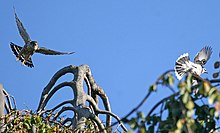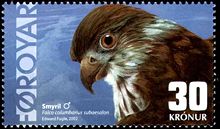Merlin (bird)
| Merlin | |
|---|---|

| |
| European subspecies, F. c. aeasalon Male (front) and female (behind) | |
| Scientific classification | |
| Kingdom: | |
| Phylum: | |
| Class: | |
| Order: | |
| Family: | |
| Genus: | |
| Species: | F. columbarius
|
| Binomial name | |
| Falco columbarius Linnaeus, 1758
| |
| Subspecies | |
|
3-9, see text. | |
| Synonyms | |
|
Aesalon columbarius | |
The Merlin (Falco columbarius) is a smallish falcon that breeds in northern North America, Europe and Asia. In North America it was once and sometimes still is colloquially called "pigeon hawk" though being a falcon it is not very closely related to true hawks.
This bird of prey is 24-33 cm (9.5-13 in) long with a 53-69 cm (21-27 in) wingspan. Males average at about 165 g (5.8 oz) and females are typically about 230 g (8 oz). Compared to other small falcons, they are more robust and heavily built. The male Merlin has a blue-grey back and orange-tinted underparts. The female and immature are dark brown above and whitish spotted with brown below. American subspecies range from pale (Great Plains) to nearly black (Pacific Northwest). Besides a weak eye-stripe in adults, the faces are less strongly patterned than most falcons. Light males may resemble the American Kestrel, but the grey, not brown back and tail of the Merlin are characteristic.
Systematics
The relationships of the Merlin are not resolved to satisfaction. In size and coloration, it is fairly distinct among living falcons. The Red-necked Falcon is sometimes considered more closely related to the Merlin than other falcons, but this seems to be a coincidence due to similar hunting habits; it could not be confirmed in more recent studies. Indeed, the Merlin seems to represent a lineage distinct from other living falcons since at least the Early Pleistocene, some 5 mya (million years ago). As supported by biogeography and DNA sequence data, it might be part of an ancient radiation of Falcos from Europe to North America, alongside the ancestors of forms such as the American Kestrel, and the Aplomado Falcon and its relatives.[2]
It is interesting to note a fossil falcon from the Early Blancan (4.3–4.8 mya) of Kansas.[3] Slightly smaller than a Merlin but otherwise rather similar, it might have been the ancestor of the living species, or a close relative of those birds.[4]
Subspecies

That the Merlin has a long-standing presence on both sides of the Atlantic is evidenced by the degree of genetic distinctness between Eurasian and North American populations. Arguably, they might be considered distinct species.[5]
By and large, color variation in either group independently follows Gloger's Rule. The Pacific temperate rain forest subspecies suckelyi's males are almost uniformly black on the upperside and have heavy black blotches on the belly, whereas those of the lightest subspecies, pallidus, have little non-dilute eumelanin altogether, with grey upperside and reddish underside pattern.
Eurasian group (may be a distinct species Falco aeasalon)
- F. c. aeasalon Tunstall, 1771
- Northern Eurasia, from British Isles through Scandinavia to central Siberia. Population of northern Britain shows evidence of gene flow from subaesalon. British Isles population resident, rest migratory.
- F. c. subaesalon C.L. Brehm, 1827
- Iceland and Faroe Islands. Latter population has some gene flow with aesalon. Resident.
- F. c. pallidus (Sushkin, 1900)
- Asian steppes between Aral Sea and Altay Mountains. Migratory.
- F. c. insignis (Clark, 1907)
- Siberia between Yenisei and Kolyma Rivers. Migratory.
- F. c. lymani Bangs, 1913
- Mountains of eastern Kazakhstan and surrounding countries. Migratory.
- F. c. pacificus (Stegmann, 1929)
- Russian Far east to Sakhalin. Migratory.
American group
- F. c. columbarius Linnaeus, 1758
- Northern North America east of Rocky Mountains, except Great Plains. Migratory.
- F. c. richardsoni Ridgway, 1871
- Great Plains. Resident.
- F. c. suckleyi Ridgway, 1873
- Pacific coast of North America, from S Alaska to N Washington state. Resident.
Ecology

Merlins breed in open country such as moorland, taiga or willow or birch scrub. Like the larger Peregrine Falcon, it is migratory, wintering in more temperate regions. Northern European birds move to southern Europe and North Africa, and North American populations to the southern USA and northern South America. In winter, the Merlin may be found in almost any open country, from coasts to prairies to desert scrub. In the mildest parts of its breeding range, such as Great Britain, it will desert higher ground and move to coasts and lowland.
In Europe, Merlins will roost communally in winter, often with Hen Harriers. In North America, communal roosting is rare, and Merlins are well known for fiercely attacking any birds of prey that they encounter, even adult eagles.
Merlins rely on speed and agility to hunt their prey. They often hunt by flying fast and low, typically less than 1 metre above the ground, trying to take prey by surprise. Prey will sometimes attempt to outfly the Merlin, which result in the falcon "tail-chasing" after them. Most of their prey are smallish birds (10-40 g), with local preferences for larks, pipits, sandpipers and House Sparrows. Almost any bird that is locally abundant will be taken, up to the size of Rock Pigeons. Breeding pairs will frequently hunt cooperatively, with one bird flushing the victims towards their mate. Other prey includes insects (especially dragonflies and moths), small mammals (especially bats and voles) and reptiles.
Reproduction
Most Merlins will use abandoned corvid or hawk nests which are in conifer or mixed tree stands. They will also set up a nest on cliff-faces and on the ground. In the UK, the female will usually make a shallow scrape on heather moorland to use as a nest. They have a preference for long heather so are susceptible to over management, by burning. Most nest sites have dense vegetative or rocky cover. Three to five (usually four) eggs are laid. The rusty brown eggs average at about 40 x 31.5 mm (1.58 x 1.24 in). The incubation period is 28 to 32 days. The female does almost all of the incubating, while the male hunts and feeds both her and their young. Hatchlings are about 13 g and are brooded for about 7 days. The fledging stage is reached at about 29 days and are dependent on their parents for up to 4 weeks. Sometimes first-year Merlins (especially males) will choose to serve as a "nest helper" for an adult pair. Corvids are the primary threat to eggs and nestlings. Adult Merlins may be preyed on by larger raptors, especially Peregrine Falcons, Great Horned Owls and larger Accipiter hawks (like Goshawks), but most other birds avoid Merlins due to their aggressiveness.

.
Relationship with humans

In medieval Europe, Merlins were popular in falconry. By far the most serious long-term threat to these birds is habitat clearance, especially in their breeding areas, while a frequent cause of death for individual birds is collision with man-made objects.
In Art
John James Audubon illustrates the Merlin in Birds of America, Second Edition (published, London 1827-38) as Plate 75 under the title, "Le Petit Caporal - Falco temeratius". The image was engraved and colored by Robert Havell's, London workshops. The original watercolor by Audubon was purchased by the New York History Society where it remains to this day (January 2009).
William Lewin illustrates the Merlin as Plate 22 in volume 1 of his Birds of Great Britain and their Eggs published in London, 1789.
Footnotes
- ^ Template:IUCN2006 Database entry includes justification for why this species is of least concern
- ^ Helbig et al. (1994), Wink et al. (1998), Griffiths (1999), Groombridge et al. (2002).
- ^ Fox Canyon Local Fauna; see Martin et al. (2000) for dating. Known from some limb bones, UMMP V27159, V29107, V57508-V57510, and perhaps[verification needed] V57513/V57514.
- ^ Feduccia (1970)
- ^ Wink et al. (1998)
See also
References
- Feduccia, J. Alan (1970): Some birds of prey from the Upper Pliocene of Kansas. Auk 87(4): 795-797. DjVu fulltext PDF fulltext
- Griffiths, Carole S. (1999): Phylogeny of the Falconidae inferred from molecular and morphological data. Auk 116(1): 116–130. DjVu fulltext PDF fulltext
- Groombridge, Jim J.; Jones, Carl G.; Bayes, Michelle K.; van Zyl, Anthony J.; Carrillo, José; Nichols, Richard A. & Bruford, Michael W. (2002): A molecular phylogeny of African kestrels with reference to divergence across the Indian Ocean. Mol. Phylogenet. Evol. 25(2): 267–277. doi:10.1016/S1055-7903(02)00254-3 PDF fulltext
- Helbig, A.J.; Seibold, I.; Bednarek, W.; Brüning, H.; Gaucher, P.; Ristow, D.; Scharlau, W.; Schmidl, D. & Wink, Michael (1994): Phylogenetic relationships among falcon species (genus Falco) according to DNA sequence variation of the cytochrome b gene. In: Meyburg, B.-U. & Chancellor, R.D. (eds.): Raptor conservation today: 593-599. PDF fulltext
- Henninger, W.F. (1906): A preliminary list of the birds of Seneca County, Ohio. Wilson Bull. 18(2): 47-60. DjVu fulltext PDF fulltext
- Martin, R.A.; Honey, J.G. & Pelaez-Campomanes, P. (2000): The Meade Basin Rodent Project; a progress report. Kansas Geologial Survey Open-file Report 2000-61[verification needed]. Paludicola 3(1): 1-32.
- Wink, Michael; Seibold, I.; Lotfikhah, F. & Bednarek, W. (1998): Molecular systematics of holarctic raptors (Order Falconiformes). In: Chancellor, R.D., Meyburg, B.-U. & Ferrero, J.J. (eds.): Holarctic Birds of Prey: 29-48. Adenex & WWGBP. PDF fulltext
External links
- Merlin Falcon Foundation A non-profit organization that researches the Coastal Forest Merlin's life history and educates scientists and citizens about this raptor's importance to the Northwest environment.
- Cornell Lab of Ornithology - Merlin
- USGS Patuxent - Merlin
- South Dakota Birds - Merlin Information and Photos
- Picture of Black Merlin (Falco columbarius suckleyi subspecies)
- Oiseaux Photos.
- Identification guide (PDF) by Javier Blasco-Zumeta
- Sounds of Merlin by Martyn Stewart

